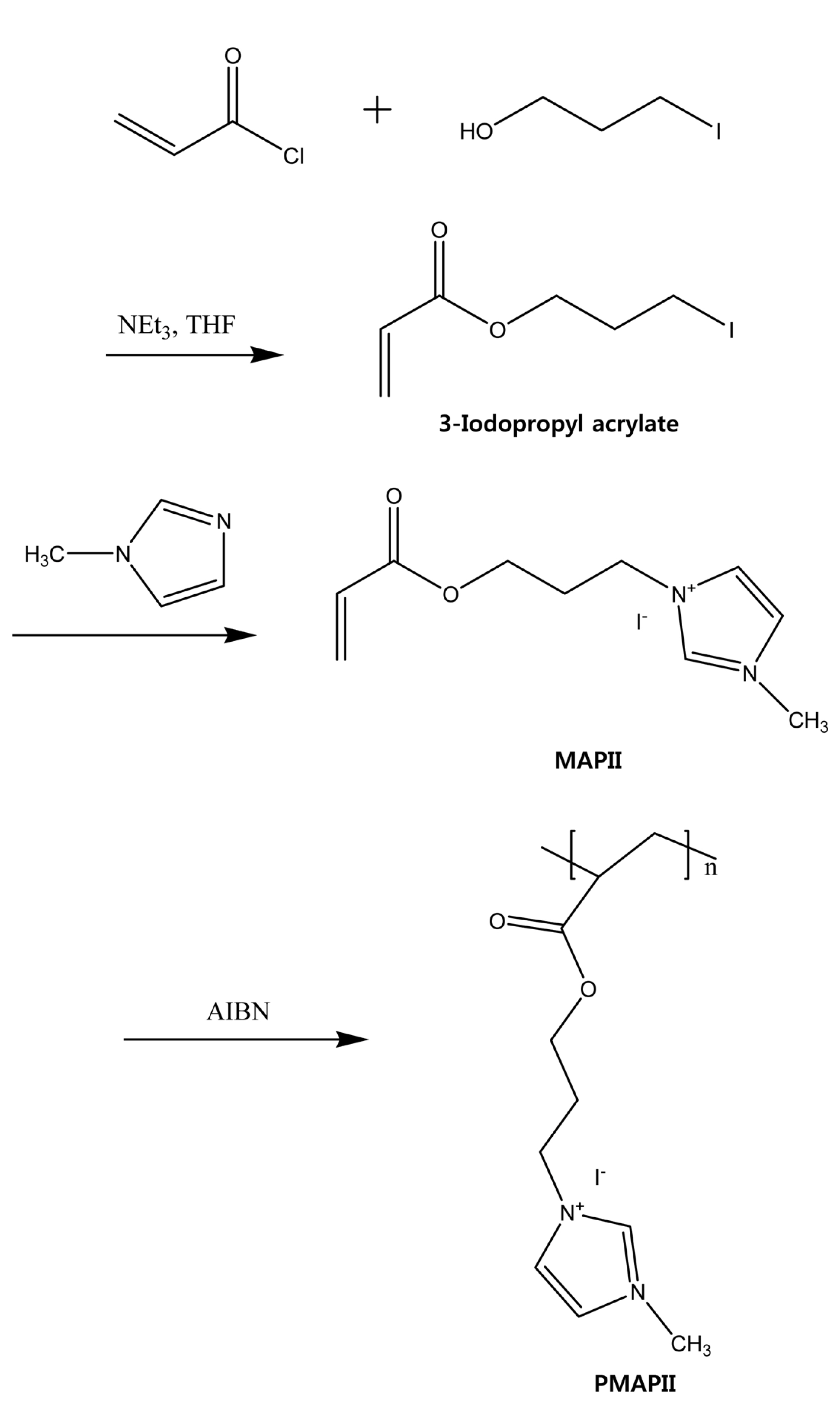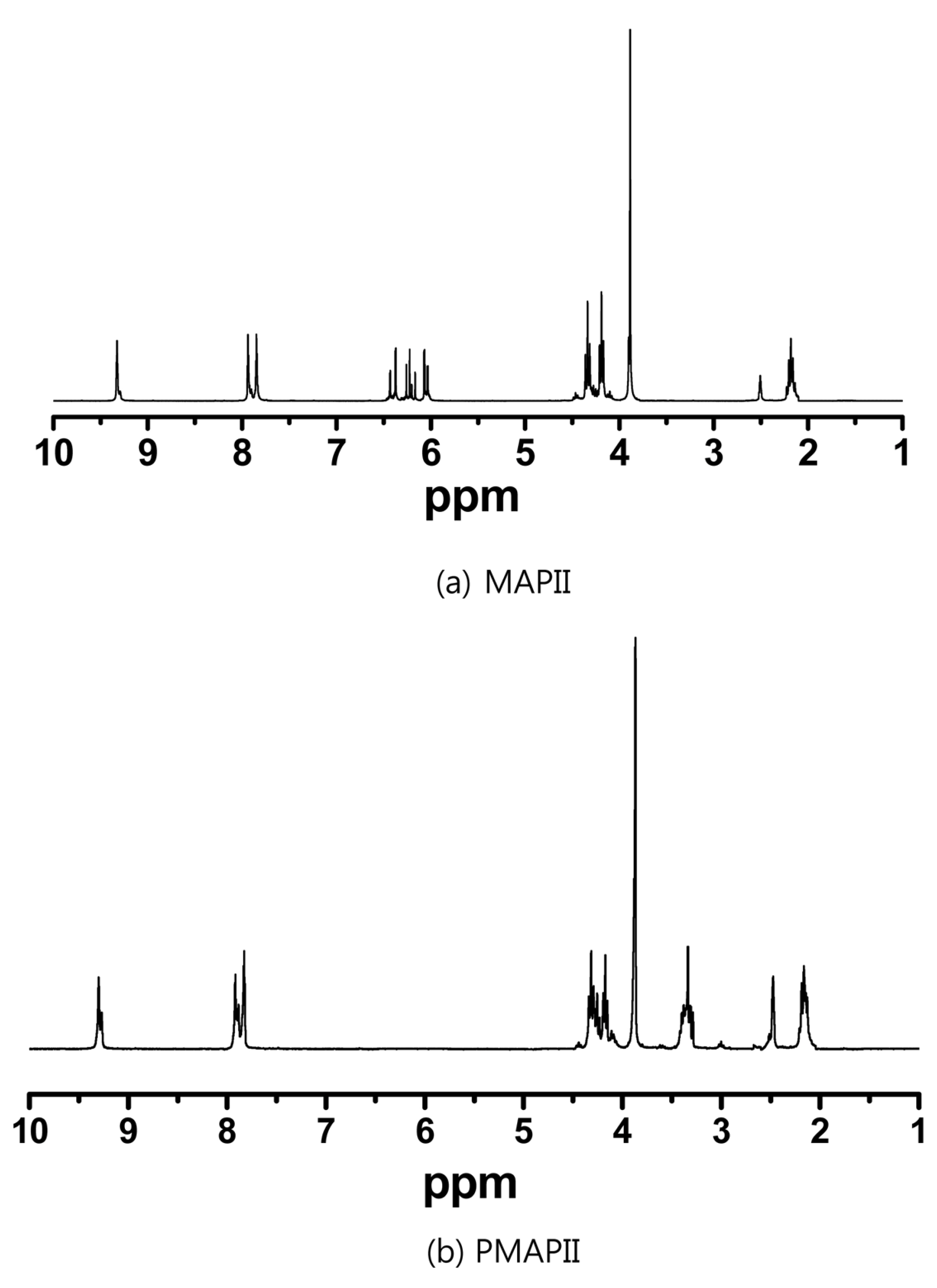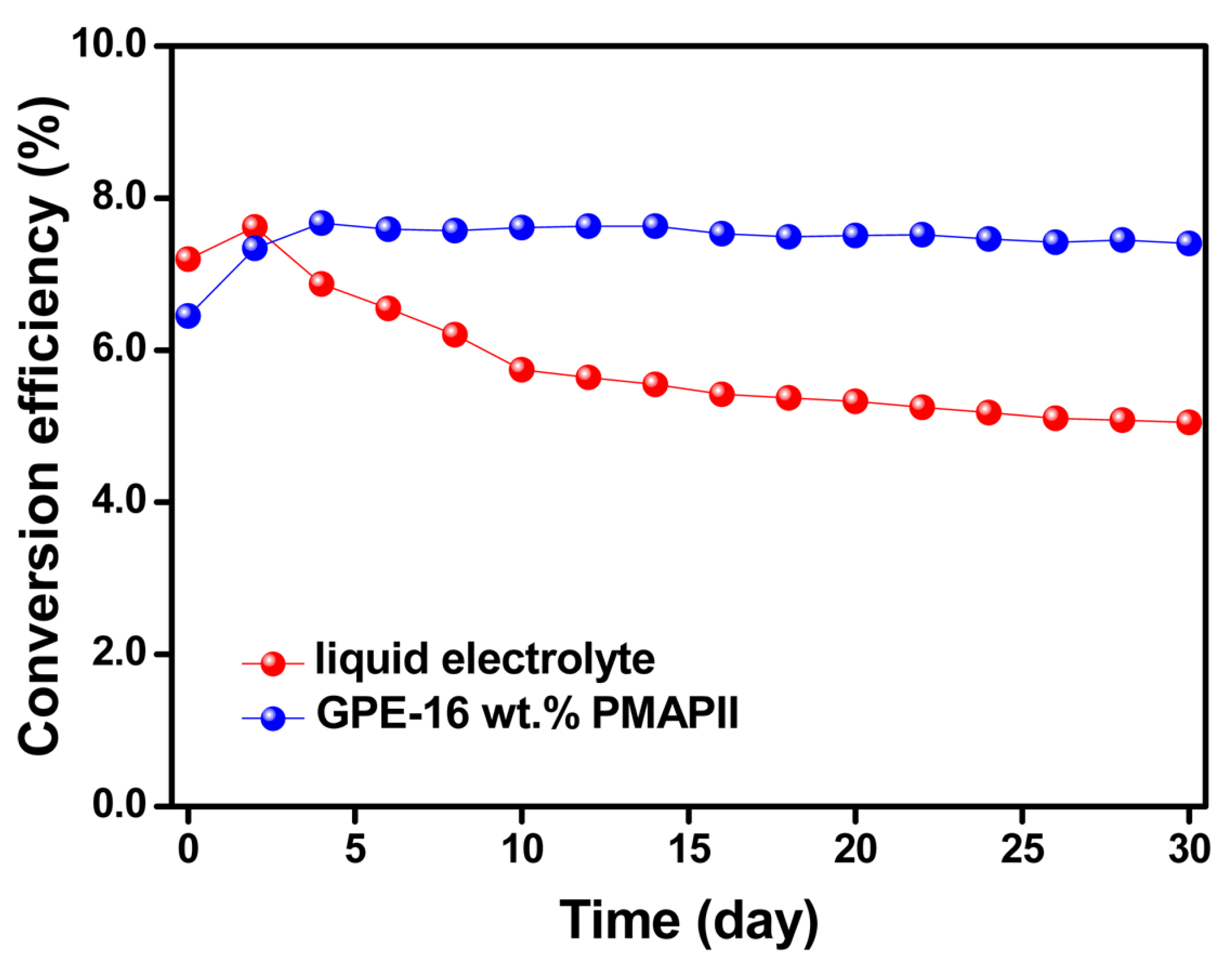1. Introduction
Since O’Regan and Gratzel’s first report of a dyesensitized solar cell (DSSC) in 1991, DSSCs have attracted a great deal of attention as a potential replacement for conventional silicon solar cells because of their low cost, ease of fabrication, and relatively high conversion efficiency [1-5]. However, the potential problems caused by the liquid electrolytes, such as the leakage or evaporation of the organic solvent, are considered critical problems that limit the long-term operation and large-scale production of DSSCs. To overcome these problems, considerable efforts have been devoted to replacing the liquid electrolytes with polymer electrolytes [6-18]. However, solid polymer electrolytes show low ionic conductivity at ambient temperatures and poor electrolyte–electrode interfacial contacts, resulting in low conversion efficiency. On the other hand, gel polymer electrolytes that exhibit high ionic conductivity improve the conversion efficiency of DSSCs. However, in gel polymer electrolytes, both cations and anions are mobile, thereby polarizing the electrolyte and increasing the resistance of I-/I3- ions [19]. Accordingly, it is desirable to use a single-ion-conducting gel polymer electrolyte in which the cations are immobilized to the polymer backbone and the anions (I-) are highly mobile. Among the single-ion-conducting electrolytes, polymeric ionic liquids represent an important class of polymer electrolytes in which the cationic or anionic centers are confined to the repeating unit [20-29]. Although polymeric ionic liquid-based electrolytes have been extensively studied, their ionic conductivities are too low for practical applications at ambient temperature [30].
In this work, we report the synthesis and electro-chemical characteristics of gel polymer electrolytes based on a polymeric ionic liquid, poly(1-methyl 3-(2-acryloyloxypropyl) imidazolium iodide) (PMAPII), in which iodide ions can easily migrate, while the imidazolium cations are immobilized to the polymer backbone. Gel polymer electrolytes with high conductivity and enhanced stability were prepared by blending iodine, 4-tert-butylpyridine (TBP), γ-butyrolactone (GBL), and PMAPII. PMAPII played an important role in not only increasing the concentration of I- ions but also forming the stable gel polymer electrolyte. No additional iodide salts such as LiI were used to form the redox couple (I-/I3-) in the gel polymer electrolytes. The photovoltaic performance of quasi-solid-state DSSCs assembled with these gel polymer electrolytes was investigated and compared to that of the liquid-electrolyte-based DSSC. Our results demonstrated that the DSSC employing the PMAPII-based gel polymer electrolytes exhibited a relatively high conversion efficiency of 7.67% and good long-term stability.
2. Experimental
2.1. Synthesis of PMAPII
PMAPII was synthesized in three steps (Fig. 1), as previously described in detail for the synthesis of other similar polymeric ionic liquid systems [31-33]. First, 3-iodo-1-propanol (Aldrich) dissolved in tetrahydrofuran (THF) with a catalytic amount of triethylamine was fed into a glass reactor. A solution with a slight molar excess of acryloyl chloride (Aldrich) in THF was added dropwise to the reactor over a period of 1 h under an N2 atmosphere at 0°C. After the entire solution was added, the solution was vigorously stirred for another 24 h. The triethylamine salt was filtered off, and the product (3-iodopropyl acrylate) was obtained by removing the THF using a rotary vacuum evaporator. For the quaternization reaction, a mixture of the as-prepared 3-iodopropyl acrylate and n-methylimidazole (Aldrich) was dissolved in ethanol and stirred at 45°C for 24 h under an N2 atmosphere. The product was purified by precipitation with diethyl ether to obtain 1-methyl 3-(2-acryloyloxypropyl) imidazolium iodide (MAPII). The obtained MAPII monomer was polymerized with azobisisobutyronitrile (AIBN) as a free-radical initiator in dimethylsulfoxide (DMSO) at 80°C for 12 h under an N2 atmosphere. After polymerization, the resulting solution was added dropwise into a large excess of diethyl ether. The polymer was washed successively with diethyl ether to remove any impurities such as residual monomer and initiator. The polymer was then dried in a vacuum oven at 120°C for 24 h. The obtained polymeric ionic liquid (PMAPII) was a flexible solid. The chemical structures of MAPII and PMAPII were confirmed by 1H NMR spectra using a VARIAN (Mercury 300) NMR spectrometer with a DMSO-d6 solvent.
2.2. Cell assembly
To prepare the gel polymer electrolyte, various amounts (12, 14, 16, 18, 20 wt.%) of PMAPII were separately added to the liquid electrolyte. The liquid electrolyte used in this study was a solution of 0.05 M I2 and 0.05 M TBP dissolved in GBL. A nanocrystalline TiO2 paste (Ti-Nanoxide T20/SP, Solaronix) was cast onto a fluorine-doped tin oxide (FTO)-coated glass using a doctor blade, which was sintered at 450°C for 30 min. Then, this electrode was sensitized overnight with a cis-diisothiocyanatobis(2,2’-bipyridyl-4,4’-dicarboxylato) ruthenium (II) bis(tetrabutyl ammonium) (Ruthenium 535 bis-TBA, Solaronix) dye solution. A Pt counter electrode was prepared by spin-coating 0.01 M H2PtCl6 in isopropanol onto FTO glass and sintering at 450°C for 30 min. The gel polymer electrolyte was directly cast onto the TiO2 electrode. The cell was then fabricated by sealing the TiO2 electrode and Pt counter electrode together using a hot melting film. The thickness of the gel polymer layer between two electrodes was about 15 μm, and the cel l geomet ry was 0.5 × 0.5 cm2.
2.3. Measurements
The ionic conductivity of the gel polymer electrolyte was measured by electrochemical impedance spectroscopy using a Zahner Electrik IM6 impedance analyzer over a frequency range of 10 Hz to 100 kHz with an amplitude of 10 mV. A two-electrode electrochemical cell consisting of a gel polymer electrolyte sandwiched between two identical Pt electrodes was used to measure the diffusion coefficient of the triiodide ion from the diffusion-limited current measurements [34,35]. The diffusion-limited current density was determined by cyclic voltammetry at a scan rate of 5 mV s−1. The surface and cross-sectional morphologies of the TiO2 electrodes were examined using a field emission scanning electron microscope (FE-SEM, JEOL, JSM-6710F). The photovoltaic performance of the DSSCs was evaluated using a xenon light source (100 mW cm−2) with an AM 1.5 filter in a solar simulator. The light intensity was calibrated with a NREL-calibrated Si solar cell (PV Measurements Inc.). A black mask with an aperture of 0.25 cm2 was placed over the cells during irradiation, and anti-reflection glass was placed on the front glass cover of the cells. Each performance measurement was repeated with at least five cells to obtain reproducible results. In order to evaluate the long-term stability behavior of the DSSCs, the cells were kept in the dark and only irradiated during measurements. The AC impedance of the DSSCs was measured using an impedance analyzer over a frequency range of 10 mHz to 100 kHz at open circuit under 1 Sun illumination. The applied bias voltage and ac amplitude were set to the open-circuit voltage and 10 mV, respectively. The impedance spectra were analyzed using an equivalent circuit model to interpret the characteristics of the DSSCs [36-38].
3. Results and Discussion
Fig. 2 shows the 1H NMR spectra of MAPII and PMAPII. The vinyl proton peaks (CH2=CH-) in MAPII were observed in the range of 6.0 to 6.5 ppm, as shown in Fig. 2(a). After polymerization of the MAPII monomer, the peaks clearly disappeared, and new proton peaks (-CH2-CH-) corresponding to the polymer backbone were observed around 3.36 ppm, as shown in Fig. 2(b), indicating that the MAPII monomer was polymerized to PMAPII. The protons in the imidazole ring (-CHimidazole-) appeared at 7.83, 7.92 and 9.30 ppm, as reported previously [33]. The methylene protons (-CH2-) of the side acryloyloxy-propyl unit were observed at 2.16, 4.17 and 4.32 ppm. The 1H NMR spectrum of PMAPII was consistent with the expected chemical structure.
Fig. 3 shows the diffusion coefficients of I3- and ionic conductivities of the gel polymer electrolytes as a function of the PMAPII content. As expected, the diffusion coefficient of the I3- ion in the gel polymer electrolyte decreases with increasing PMAPII content. On the other hand, the ionic conductivity first increases to a maximum value and then decreases with the further increasing PMAPII content. As mentioned earlier, no iodide salt was added to the gel polymer electrolyte, and thus, PMAPII acted as the iodide source in the redox couple (I-/I3-). Accordingly, the initial increase in ionic conductivity with the increasing PMAPII content can be ascribed to the increase in the number of free ions dissociating from PMAPII in the gel polymer electrolyte. On the other hand, the ionic mobility eventually decreases with the increasing PMAPII content due to the increase in the number of ion–dipole interactions between PMAPII and GBL. Thus, the decrease in ionic conductivity with more than 16 wt.% PMAPII was attributed to the decrease in ionic mobility with the increasing PMAPII content. At 16 wt.% PMAPII, the ionic conductivity and diffusion coefficients were as high as 4.9 × 10-3 S cm−1 and 4.2 × 10-6 cm2 s−1 at room temperature, respectively.
Fig. 3.
Diffusion coefficients of I3- and ionic conductivities of gel polymer electrolytes as a function of the PMAPII content.
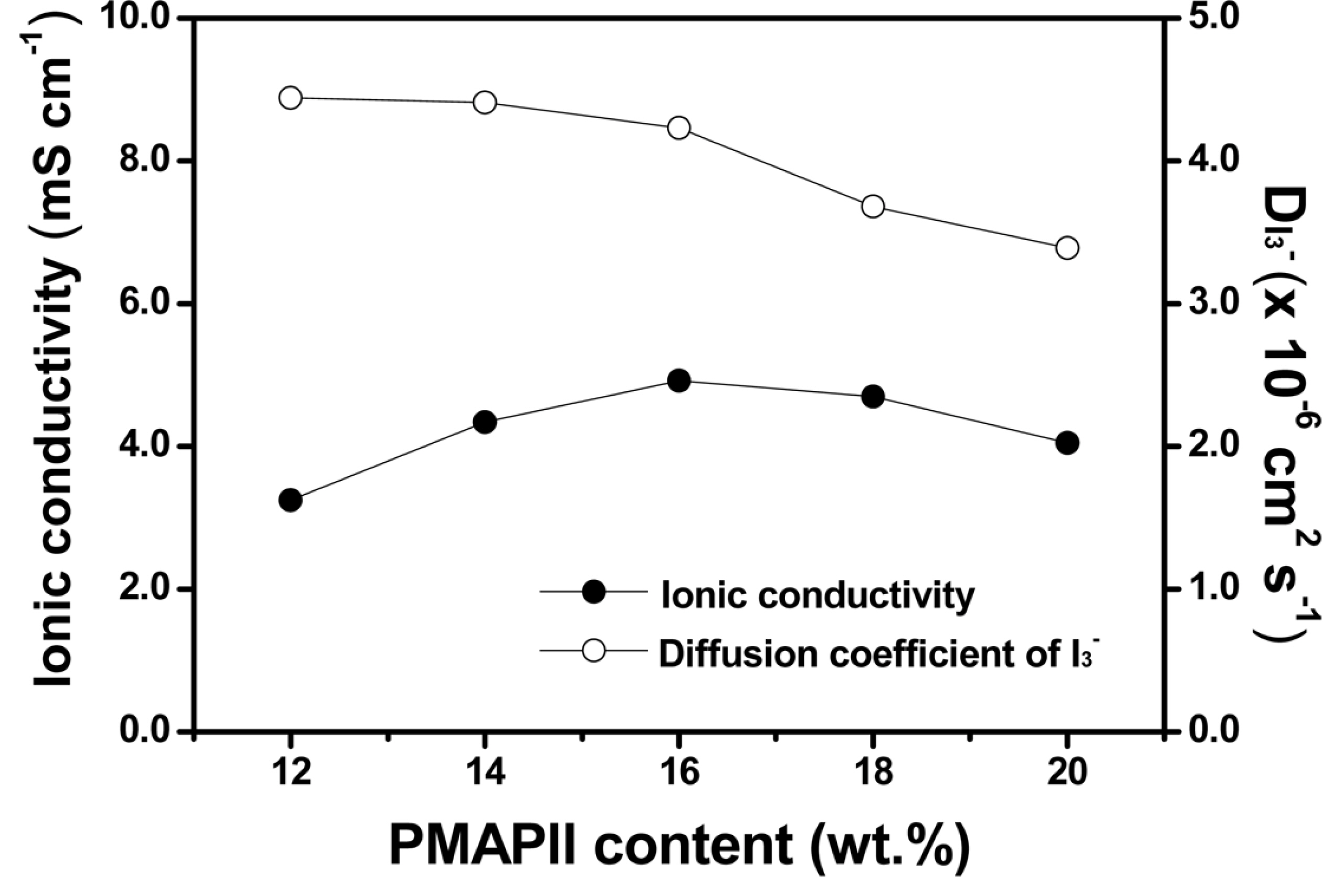
The surface morphologies of the TiO2 electrode before and after casting the gel polymer electrolyte with 16 wt.% PMAPII are shown in Fig. 4(a) and (b), respectively. As shown in Fig. 4(a), the TiO2 nanoparticles were well distributed, and the electrode had a highly porous structure in which the nanoparticles were bonded together through sintering. After casting the gel polymer electrolyte onto the TiO2 electrode, the surface became smoother due to the full coverage of gel polymer electrolyte (Fig. 4(b)). Moreover, the gel polymer electrolyte penetrated into the pores of the TiO2 electrode, as shown in the cross-sectional image of the TiO2 electrode (Fig. 4(c)), which enhanced the interfacial contact between the TiO2 electrode and the gel polymer electrolyte.
Fig. 4.
Surface SEM images of a TiO2 electrode (a) before and (b) after casting the gel polymer electrolyte and (c) cross-sectional SEM image of the TiO2 electrode.
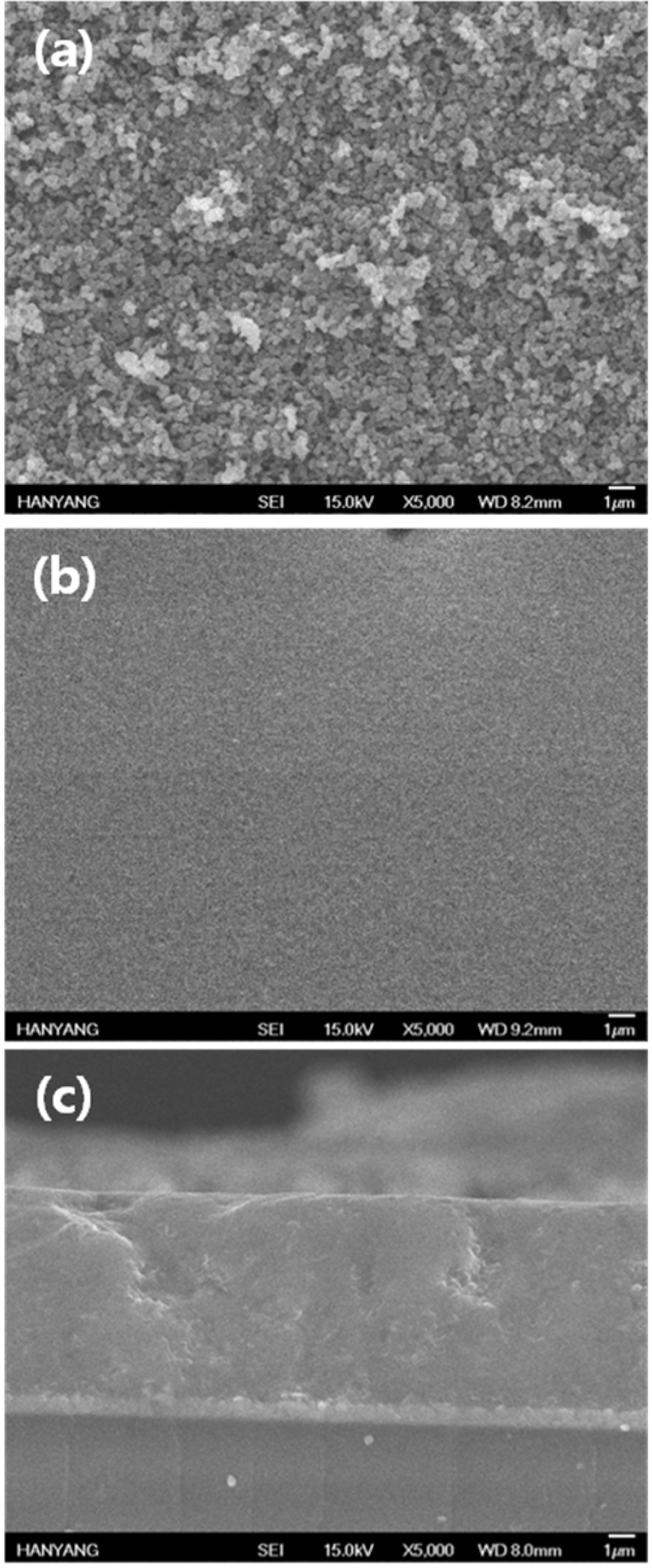
The photovoltaic performance of the DSSCs assembled with PMAPII-based gel polymer electrolytes was evaluated. Fig. 5 shows the photocurrent density–voltage curves of the DSSCs with gel polymer electrolytes containing different amounts of PMAPII. The photocurrent density–voltage curve of the DSSC prepared with a liquid electrolyte is also shown for comparison. It should be noted that 0.5 M LiI was added into the liquid electrolyte as an iodide source. Table 1 summarizes the photovoltaic performance of DSSCs with the liquid and gel polymer electrolytes. The Voc values of the DSSCs assembled with the gel polymer electrolyte were higher than that of the liquid-electrolyte-based DSSC. The presence of small Li+ cations in the liquid electrolyte may cause the band edges to shift to a more positive potential, because the Li+ cations adsorbed on the TiO2 surface are likely to induce a potential drop across the Helmholtz layer. This potential drop results in a decrease in the Voc of DSSCs based on a liquid electrolyte containing lithium iodide [39]. The increase in the Voc in the gel-electrolyte DSSCs is also ascribed to the suppression of charge recombination at the TiO2/electrolyte interface. Electrons injected into TiO2 are well known to recombine with I3- in the electrolyte. Since the I3- ions in the gel polymer electrolyte have fewer chances to interact with electrons in the TiO2, the recombination reaction can be hindered, resulting in an increase in the Voc in the DSSCs with gel polymer electrolyte and little dependence of the Voc on the PMAPII content [40,41]. On the other hand, the short circuit current densities (Jsc) of the gel-electrolyte DSSCs are lower than that of the liquid-electrolyte DSSC. The gelation of the liquid electrolyte due to the addition of PMAPII lowered the ionic conductivity and increased the interfacial resistance at the electrodes, which resulted in a decrease in the Jsc. Interestingly, the Jsc of the gel-electrolyte DSSC increased with a content of PMAPII up to 16 wt.% and decreased with further addition. The low Jsc at low PMAPII content was related to the insufficient concentration of I- ions and hence the low rate for the charge transfer reaction of the redox couple (I-/I3-) at the electrodes. A decrease in the Jsc beyond 16 wt.% PMAPII can be attributed to the decrease in the ionic mobility, as explained earlier. These results suggest that the concentration of iodide ions and the ionic mobility should be balanced to achieve the highest conversion efficiency. The quasisolid- state DSSC assembled with the 16 wt.% PMAPII gel polymer electrolyte exhibited a relatively high initial conversion efficiency of 6.45% at 100 mW cm−2.
Table 1.
Photovoltaic performance of DSSCs assembled with liquid and gel polymer electrolytes (GPEs).

In order to investigate the impedance behavior of the liquid- and gel-electrolyte DSSCs, the ac impedance of the cells was measured, and the results are shown in Fig. 6. These spectra can be analyzed by using the equivalent circuit given in the inset of the figure [36-38]. All the spectra exhibit three semicircles, which can be assigned to the electrochemical reaction at the Pt counter electrode (Rct1), the charge transfer reaction at the TiO2 electrode (Rct2), and the Warburg diffusion process of I-/I3- (Rdiff). The resistances estimated using the equivalent circuit are given in Table 2. The electrolyte resistance (Rel) is lowest in the DSSC assembled with liquid electrolyte. In the gel-electrolyte DSSCs, the electrolyte resistance decreased with the PMAPII content up to 16 wt.% and then increased with higher contents, which is consistent with the ionic conductivity results in Fig. 3. When the content of PMAPII was less than 16 wt.%, the observed interfacial resistances (Rct1 and Rct2) were high, which may be due to the lack of ions involved in the redox couple (I-/I3-). The Warburg diffusion resistance (Rdiff) of the redox couple increased with the PMAPII content, which can be ascribed to the decrease in ionic mobility. This result indicated that adding the appropriate amount of PMAPII containing iodide ions not only decreases the electrolyte resistance but also improves the charge transfer reaction at both the TiO2 electrode and Pt counter electrode, resulting in a high conversion efficiency, which is consistent with the photovoltaic performance of the DSSCs shown in Fig. 5.
Fig. 5.
Photocurrent density–voltage curves of the DSSCs with the liquid electrolyte and the gel polymer electrolytes containing different amounts of PMAPII at 100 mW cm−2.
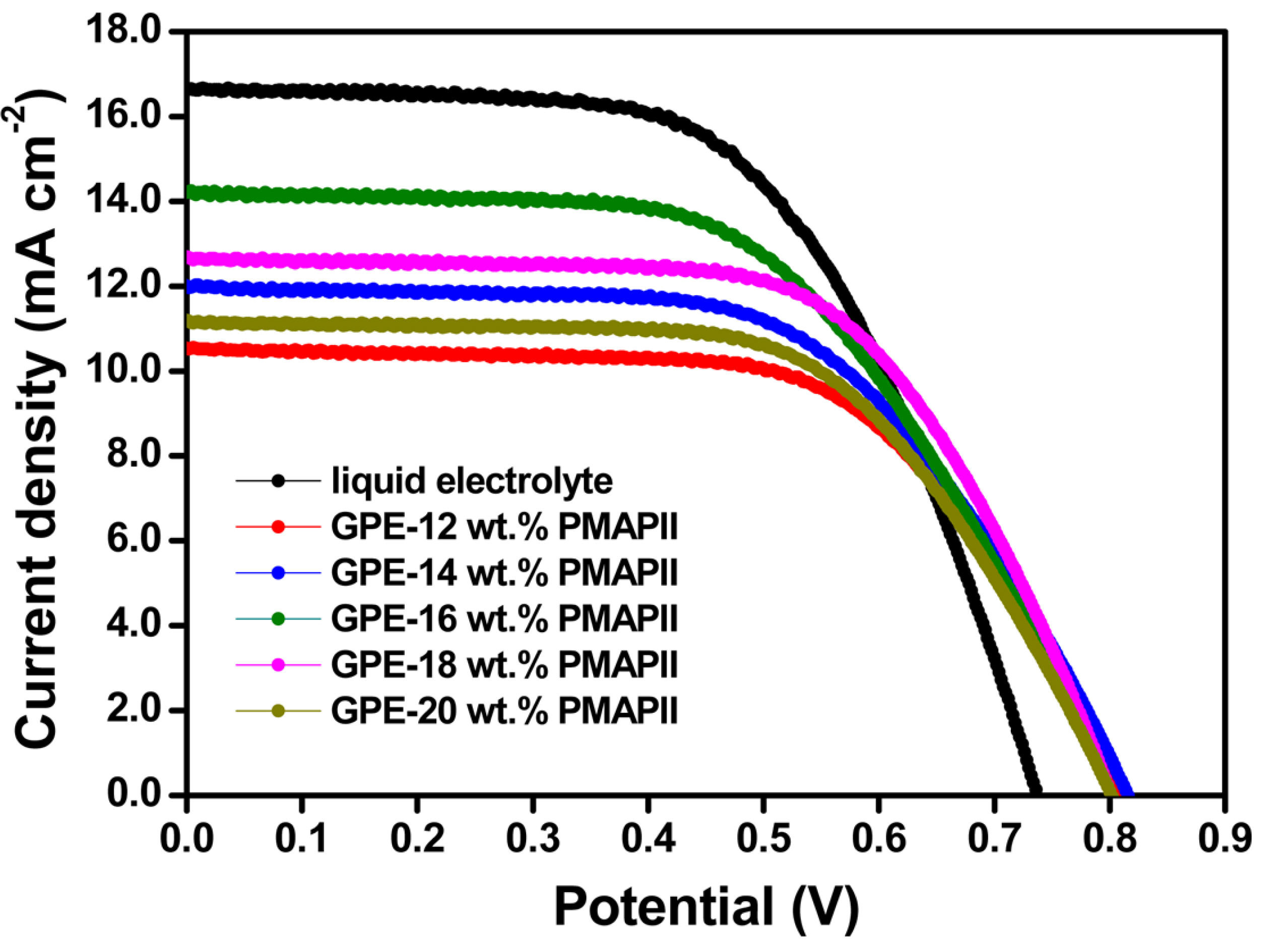
Fig. 6.
AC impedance spectra of DSSCs assembled with liquid and gel polymer electrolytes recorded at 100 mW cm−2 under open circuit conditions.
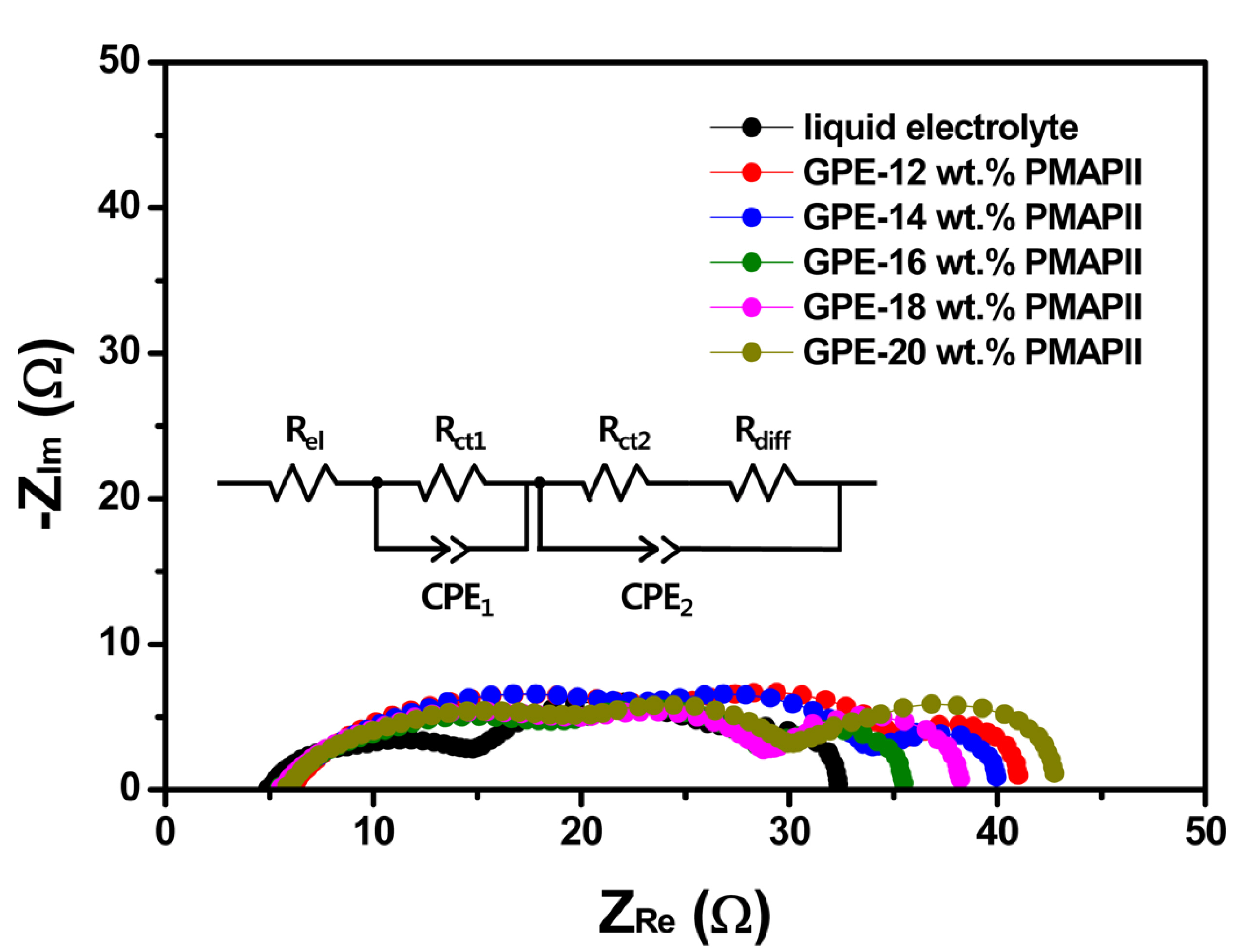
Table 2.
Rel, Rct1, Rct2 and Rdiff estimated from the electrochemical impedance data and equivalent circuit.

The long-term durability of a quasi-solid-state gel-electrolyte DSSC was evaluated and compared to that of the liquid-electrolyte-based DSSC. Fig. 7 compares the variation in the conversion efficiency of the liquid-electrolyte DSSC with that of the 16 wt.% PMAPII gel-electrolyte DSSCs as a function of storage time. As shown in the figure, the longterm stability of the gel-electrolyte DSSC was obviously superior to that of the liquid-electrolyte DSSC. The conversion efficiency in the liquid-electrolyte DSSC decayed continuously with time over the investigated period. After 30 days, the cell lost 30% of its initial conversion efficiency due to the leakage or evaporation of the liquid electrolyte. On the other hand, the conversion efficiency of the quasi-solidstate gel-polymer DSSC slightly increased and then remained almost constant. Notably, its conversion efficiency increased from its initial efficiency of 6.45% to 7.67% after 4 days, which is higher than the initial conversion efficiency of the liquid-electrolyte-based DSSC (7.20%). The initial increase in the conversion efficiency can be ascribed to the improvement in the interfacial contact between the TiO2 electrode and electrolyte with time. When the gel polymer electrolyte was employed, the organic solvent was well encapsulated in the quasi-solid-state DSSC due to the strong ion–dipole interactions between PMAPII and GBL. The adhesive property of the gel polymer electrolyte also promoted the interfacial contact between the dye-adsorbed TiO2 electrode and the platinum counter electrode, providing the DSSC with more stable performance than that of the liquid-electrolyte DSSC.
4. Conclusions
A polymeric ionic liquid, PMAPII, was synthesized and used as both a gelling agent and iodide source for quasi-solid-state DSSCs. PMAPII played an important role in not only increasing the concentration of I- ions but also forming a stable gel polymer electrolyte. The content of PMAPII was optimized to 16 wt.% to strike a balance between the iodide ion concentration and the ionic mobility to achieve the highest conversion efficiency. The quasi-solid-state DSSC assembled with the 16 wt.% PMAPII gel polymer electrolyte exhibited a relatively high conversion efficiency of 7.67% at 100 mW cm−2 and better stability than the DSSC with the liquid electrolyte.




